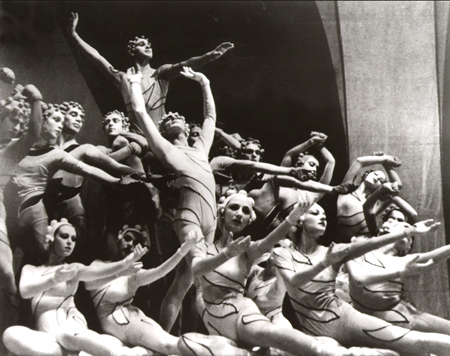

Reviews of Recent Independent, Foreign, & Documentary Films in Theaters and DVD/Home Video
Directed & Produced by: Dan Geller & Dayna Goldfine. Produced by: Dan Geller, Dayna Goldfine, Robert Hawk & Douglas Blair Turnbaugh. Written by: Dan Geller, Dayna Goldfine, Celeste Schaefer Snyder & Gary Weimberg. Director of Photography: Dan Geller. Edited by: Dan Geller & Dayna Goldfine & Gary Weimberg. Music by: Todd Boekelheide & David Conte. Released by: Zeitgeist. Country of Origin: USA. 118 min. Not Rated. Narrated by: Marian Seldes. DVD Features: 16:9 anamorphic transfer, enhanced for widescreen TVs. An hour-long, four-part series of additional behind-the-scenes, performance, rehearsal and interview footage with Ballets Russes dancers. Archival footage, including performance excerpts from Swan Lake, Giselle & others. Stills galleries featuring 200 photos of Ballets Russes stars, dancers & vintage program covers. Trailer. English subtitles for the deaf & hearing impaired. 12-page booklet including liner notes by The New York Times dance writer Jack Anderson & production notes by the filmmakers.
The impetus for the film was the first ever official reunion of Ballet Russes dancers in June 2000. The filmmakers have
beautifully captured the reunion's excitement as well as the 60-year history which led up to it. Interviews with some of the
greatest dancers of the 20th century trace the history of the two ballet companies, which were born after the death of the founder,
choreographer Serge Diaghilev: The Ballet Russe de Monte Carlo directed by Massine, and the Original Ballet Russe, led by
Colonel de Basil. Following in the Diaghilev tradition, both companies competed for and employed the most innovative artists,
including Nijinsky, Balanchine, Picasso, Stravinsky, Matisse and Dalí. In addition to the engaging interviews, there is great
archival footage of the dancers in performance, capturing for all time classical ballet at its peak. For anyone interested in
the arts, this film is a must see. Haila Strauss, choreographer of over 100 musical theatre productions, associate professor of theatre and dance, Marymount Manhattan College
DVD Extras: The immersion into the world of dance engagingly continues within the deleted/additional scenes, where the conversation remains chatty, sometimes catty, and candid: dancer Frederic Franklin remembers the actual Armistice Day of 1918; he and fellow dancer Marc Platt bluntly assess Richard Rogers’ score for the ballet Ghost Town; heartthrob George Zoritch makes fun of Nureyev and Baryshnikov; and Irina Baronova hilariously recounts her elopement and inappropriate honeymoon attire when she was barely 16. The most hilarious moment in the film itself is ballerina Nathalie Krassovska laughing at the memory of her own short-lived marriage and at her “men problems.” (Capturing Krassovska as she still practices in her eighties, the documentary suggests the elixir of youth may be found at the barre.) The freewheeling interviews are a counterpoint to the reverential and beautifully enunciated narration of Marian Seldes. And some of the most fascinating footage is not for dancers only: In the rehearsal studio, Franklin, around age 88, supervises by memory a ballet that was
last performed in 1942; and Alan Howard coaches one en pointe young man from the all-male troupe, Les Ballets Trockadero de Monte Carlo.
As in the film, the archival ballet footage is really only snippets set to music not in sync with the dancers.
(The footage must have been shot without sound.) To see one of the profiled artists in action, watch Michael Powell and
Emeric Pressburger’s The Tales of Hoffmann, released late last year by Criterion. This, like Ballets Russes, is a must for
a dance enthusiast. The spry Léonide Massine is in full flight in this adaptation of the Offenbach opera, told almost entirely
through the choreography of Frederick Ashton. In eye-popping color and with countless memorable visual effects, this may be the best film to introduce children to ballet (ask two of the film’s fans – Martin Scorsese and George A. Romero).
Kent Turner
|